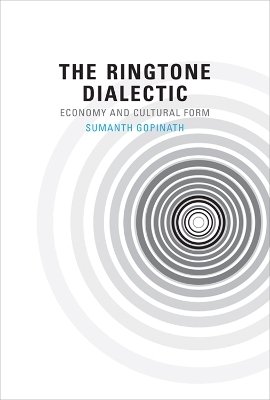
The Ringtone Dialectic
Economy and Cultural Form
Seiten
2013
MIT Press (Verlag)
978-0-262-01915-6 (ISBN)
MIT Press (Verlag)
978-0-262-01915-6 (ISBN)
- Keine Verlagsinformationen verfügbar
- Artikel merken
The rise and fall of the ringtone industry and its effect on mobile entertainment, music, television, film, and politics.
A decade ago, the customizable ringtone was ubiquitous. Almost any crowd of cell phone owners could produce a carillon of tinkly, beeping, synthy, musicalized ringer signals. Ringtones quickly became a multi-billion-dollar global industry and almost as quickly faded away. In The Ringtone Dialectic, Sumanth Gopinath charts the rise and fall of the ringtone economy and assesses its effect on cultural production.
Gopinath describes the technical and economic structure of the ringtone industry, considering the transformation of ringtones from monophonic, single-line synthesizer files to polyphonic MIDI files to digital sound files and the concomitant change in the nature of capital and rent accumulation within the industry. He discusses sociocultural practices that seemed to wane as a result of these shifts, including ringtone labor, certain forms of musical notation and representation, and the creation of musical and artistic works quoting ringtones. Gopinath examines "declines," "reversals," and "revivals" of cultural forms associated with the ringtone and its changes, including the Crazy Frog fad, the use of ringtones in political movements (as in the Philippine "Gloriagate" scandal), the ringtone's narrative function in film and television (including its striking use in the films of the Chinese director Jia Zhangke), and the ringtone's relation to pop music (including possible race and class aspects of ringtone consumption). Finally, Gopinath considers the attempt to rebrand ringtones as "mobile music" and the emergence of cloud computing.
A decade ago, the customizable ringtone was ubiquitous. Almost any crowd of cell phone owners could produce a carillon of tinkly, beeping, synthy, musicalized ringer signals. Ringtones quickly became a multi-billion-dollar global industry and almost as quickly faded away. In The Ringtone Dialectic, Sumanth Gopinath charts the rise and fall of the ringtone economy and assesses its effect on cultural production.
Gopinath describes the technical and economic structure of the ringtone industry, considering the transformation of ringtones from monophonic, single-line synthesizer files to polyphonic MIDI files to digital sound files and the concomitant change in the nature of capital and rent accumulation within the industry. He discusses sociocultural practices that seemed to wane as a result of these shifts, including ringtone labor, certain forms of musical notation and representation, and the creation of musical and artistic works quoting ringtones. Gopinath examines "declines," "reversals," and "revivals" of cultural forms associated with the ringtone and its changes, including the Crazy Frog fad, the use of ringtones in political movements (as in the Philippine "Gloriagate" scandal), the ringtone's narrative function in film and television (including its striking use in the films of the Chinese director Jia Zhangke), and the ringtone's relation to pop music (including possible race and class aspects of ringtone consumption). Finally, Gopinath considers the attempt to rebrand ringtones as "mobile music" and the emergence of cloud computing.
Sumanth Gopinath is Associate Professor of Music Theory at the University of Minnesota.
| Reihe/Serie | The Ringtone Dialectic |
|---|---|
| Zusatzinfo | 33 figures, 3 tables |
| Verlagsort | Cambridge, Mass. |
| Sprache | englisch |
| Maße | 152 x 229 mm |
| Gewicht | 680 g |
| Themenwelt | Kunst / Musik / Theater ► Musik ► Klassik / Oper / Musical |
| Geschichte ► Teilgebiete der Geschichte ► Technikgeschichte | |
| Mathematik / Informatik ► Informatik ► Web / Internet | |
| Naturwissenschaften | |
| Technik ► Nachrichtentechnik | |
| Wirtschaft ► Betriebswirtschaft / Management ► Wirtschaftsinformatik | |
| ISBN-10 | 0-262-01915-9 / 0262019159 |
| ISBN-13 | 978-0-262-01915-6 / 9780262019156 |
| Zustand | Neuware |
| Haben Sie eine Frage zum Produkt? |
Mehr entdecken
aus dem Bereich
aus dem Bereich
Buch | Softcover (2024)
Lehmanns Media (Verlag)
CHF 27,90
Digitalisierung neu denken für eine gerechte Gesellschaft
Buch | Hardcover (2023)
Quadriga (Verlag)
CHF 27,95
Vom Perceptron zum Deep Learning
Buch | Softcover (2022)
Springer Vieweg (Verlag)
CHF 27,95


